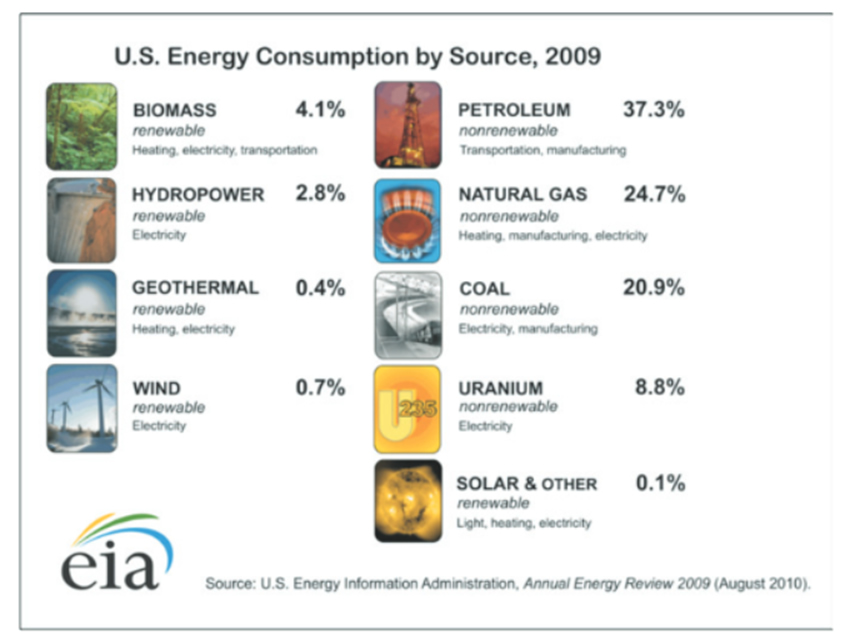What we think of as energy, is defined as the ability to do things. Energy can produce light, heat, sound, and motion. It allows us to walk and our cars to move down the road. Energy exists in many different forms, but falls into two categories- potential (stored energy) and kinetic energy (motion). Energy is constantly cycling back and forth between the two types.
ElectricityWhen we
requires understanding where energy comes from (sources) and how it is used.
Primary Energy Sources
Primary energy sources are petroleum, coal, natural gas, nuclear fuel, and renewable energy. These primary fuels are used to make secondary sources of energy (also known as energy carriers), like electricity. The top three primary energy sources consumed in the United States are petroleum (37 percent), natural gas (25 percent) and coal (21 percent). Primary energy sources are divided into two categories – renewable and nonrenewable.


Nonrenewable Sources
The top four primary energy sources in the United States are nonrenewable- coal, petroleum, natural gas, and uranium. Nonrenewable resources are those that cannot be replenished in a short time period (they are consumed much faster than they are able to be replenished). They are extracted from the ground. Fossil fuels formed millions of years ago when plants and animals died, decomposed, and were buried under layers of earth. Fossil fuels have high percentages of carbon that is released when they are burned.
All fossil fuel sources are nonrenewable, but not all non-renewables are fossil fuels. Uranium is a nonrenewable fuel but because it is released from an atom and was not formed by decaying matter, it is not a fossil fuel.
Renewable Sources
Renewable energy sources regenerate and are sustained indefinitely. Sources of renewable energy include biomass, hydropower, geothermal, wind and solar. Use of renewable energy is not new. Wind power was used for pumping water and grinding throughout ancient history. Wood (biomass) supplied 90 percent of United States energy needs more than 150 years ago. As the use of other resources expanded, reliance on renewable resources waned. Today, we are again looking for ways to incorporate renewable energy into our total energy portfolio; however, renewable energy currently represents only 8 percent of our total energy source.
Sources and Uses
Petroleum is the basis for oil products and gasoline production. Through refining, petroleum is converted into a variety of products, mostly related to transportation fuels
Natural gas is used to heat slightly more than half of the homes in the United States, but 31 percent of the supply is also used to generate electricity. Natural gas is used in industrial manufacturing as an input in agriculture-related products, such as nitrogen fertilizers, and to make plastics.
Ninety-three percent of coal production is used at power plant to generate electricity. Power plants burn coal to create steam in order to power electrical generators. Roughly half of the electricity supply in the United States is from coal.
Nuclear energy represents approximately 22 percent of the U.S. electricity supply or about 8 percent of the total energy supply. Nuclear energy is created from uranium using nuclear fission which splits the atom apart, releasing a large amount of energy.
Renewable energy makes up about 8 percent of U.S. total energy supply and was about 10 percent of the electricity supply in 2010. Hydropower is the largest renewable energy resource, representing 31 percent of the supply.
For more information please visit, E3A Understanding Energy Factsheet (SP 757-G) at the following link:
https://extension.tennessee.edu/publications/Documents/SP757-G.pdf

Investing in an energy-efficient product may save you money in the long run.
